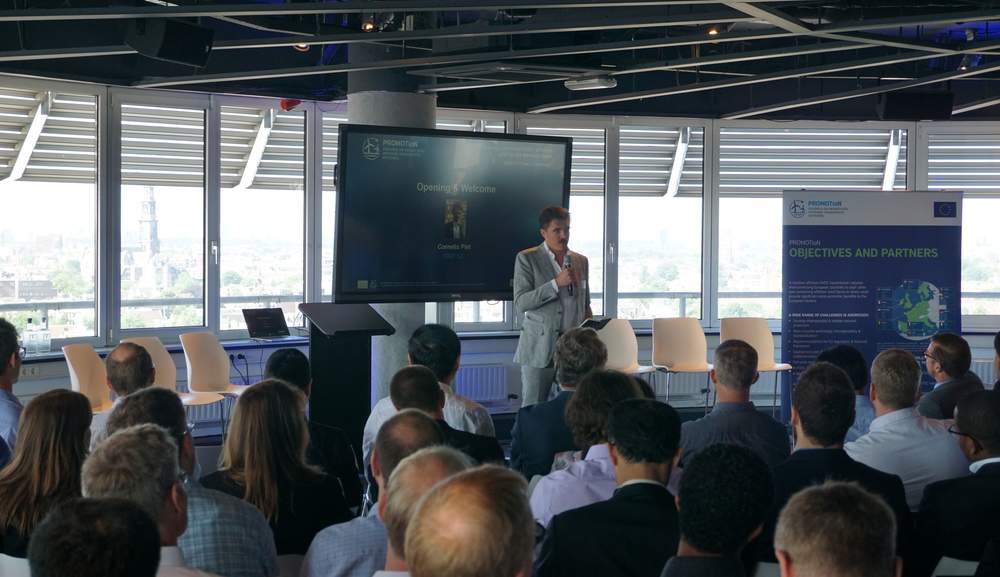Major regulatory hurdles - incentive system for investors needed
In the opening panel discussion, Giles Dickson, CEO of the European wind energy association WindEurope highlighted the considerable regulatory hurdles still impeding the development of meshed offshore grids today. Above all, investors would need incentives to prepare future wind farms and the associated infrastructure for meshed offshore grids. Christopher Jones, Advisor to the European Commission's Directorate-General for Energy, underlined the importance of PROMOTioN as the largest non-nuclear EU research project. He regarded the establishment of a cross-border offshore grid as a " hundred-billion-euro opportunity through 2050" - provided the currently existing technological and regulatory risks are overcome. Diederik Peereboom, Secretary General of T&D Europe, identified meshed offshore grids as providing a "unique opportunity to feed large quantities of offshore wind power into the existing onshore grid" and praised PROMOTioN as a means for manufacturers to demonstrate the necessary technologies. Ben Voorhorst, President of the European Network of Transmission System Operators ENTSO-E, illustrated the advantages of a meshed offshore grid by comparing it to the existing onshore grid. New legal provisions and security mechanisms were required in order to, step by step, create a highly interconnected cross-border HVDC grid.
Discussions on the financing of a meshed grid
Following the panel discussion, the conference proceedings were divided into two parallel workshops. Here, the project partners presented the interim results of the project regarding technical and regulatory issues. The initial part of the technical workshop dealt with the first research results on a number of aspects relevant to meshed offshore HVDC grids. The project partners from the Netherlands, Germany, Denmark, Belgium and Scotland focused particularly on converter technology and grid topologies. This was followed by a discussion of suitable protection systems for meshed HVDC grids, how communication between HVDC converters and wind turbines needed to be advanced and what role HVDC circuit breakers play for the overall system.
Concurrently, the project partners responsible for "Regulation and Financing", from the University of Groningen, DNV GL, Florence School of Regulation and Deutsche WindGuard, described their preliminary findings on the legal, economic and financial challenges relating to a meshed HVDC offshore grid. First, proposals for the legal classification and general regulation of meshed offshore grids were discussed. Furthermore, a cost-benefit analysis methodology (CBA) which enables the comparison of different offshore grid topologies was presented. In addition, project results addressing the economic framework were reported, e.g. questions concerning the division of costs in multilateral, cross-border projects and the financing of offshore grids.
Presentation of current research on HVDC technology
The further technical presentations primarily focused on demonstrations in the field of HVDC technology either already completed or still planned for the project. After a basic overview of the topic, the present findings on HVDC circuit breakers, HVDC system protection and control mechanisms were reported. Finally, the intersections and interactions between the two EU projects "Best Paths" and PROMOTioN were outlined. Best Paths is a major research and development project funded by the 7th EU Framework Programme for Research and Technological Development, which expires at the end of 2018. It focuses on the development of novel grid technologies on land and at sea.
PROMOTioN in the European context
The parallel workshop addressed the political and regulatory context of PROMOTioN. The perspective of the European Commission and the Support Group 2 (SG2), which deals with the issue of offshore grids as part of the North Seas Energy Cooperation, was of prime importance in this context.
The chairwoman of SG2, Sue Harrisson from the British Department for Business, Energy & Industrial Strategy, and Nicole Versijp and Henriette Niesheim from the European Commission, explained the synergies between PROMOTioN and the activities of SG2
Deployment Plan through 2050
Closing the conference, Michiel de Schepper from Dutch transmission system operator TenneT described the current status of the final development plan for a meshed offshore grid up to the year 2050, which, as part of a "roadmap", will represent the final output at the end of the PROMOTioN project.
The conference concluded with a summary of the various issues addressed in the workshops and an outlook on upcoming project results and events.
The Offshore Wind Energy Foundation, in charge of project communication, was, as one of its responsibilities, tasked with organizing the conference.
You can download the presentations of the day here.

